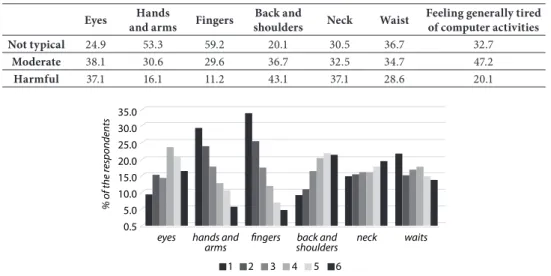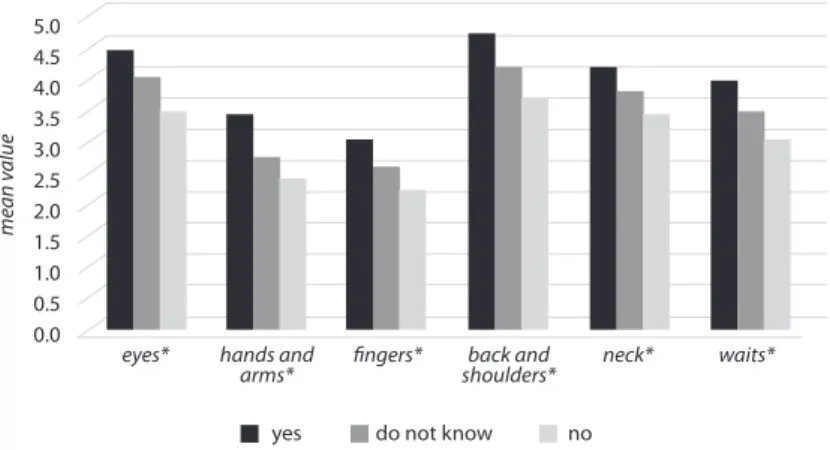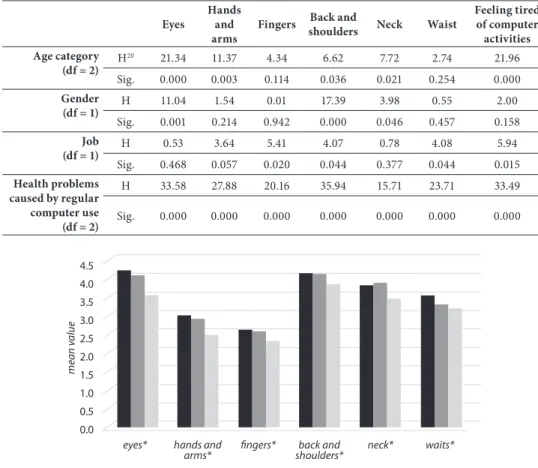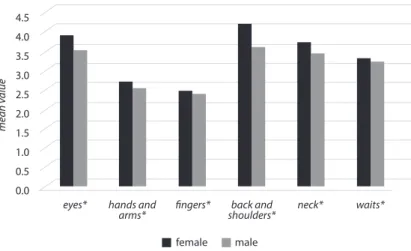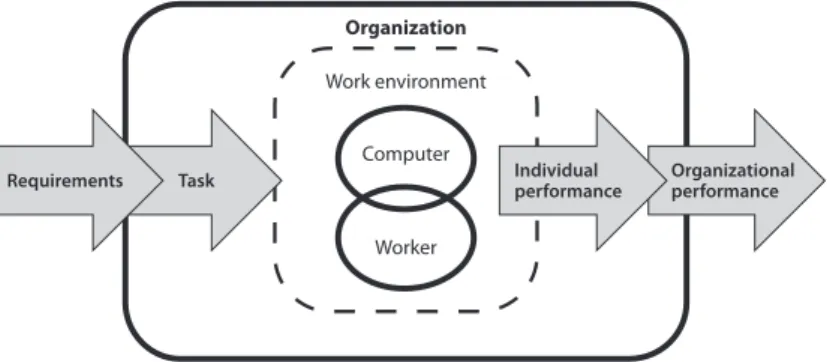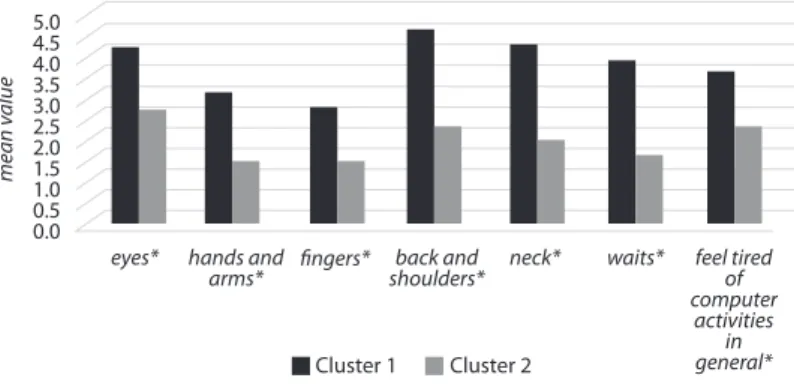St ud ies PRO PUBLICO BONO – Public Administration, 2021/1, 90–106. • László Berényi – Péter Sasvári
THE HEALTH EFFECTS OF WORKING ON THE COMPUTER: WARNING SIGNS
László Berényi, Associate Professor, University of Public Service, Faculty of Public Governance and International Studies, Department of Public Management and Information Technology, berenyi.laszlo@uni-nke.hu
Péter Sasvári, Associate Professor, University of Public Service, Faculty of Public Governance and International Studies, Department of Public Management and Information Technology, sasvari.peter@uni-nke.hu
Computerisation and digitisation are an engine of social and economic change. Implementation and coordination of both work and leisure activities are already unthinkable without computers and smart devices. The benefits of computerisation are available immediately in the forms of faster problem solving, cost-saving, or the environmental impacts of using less paper in administration.
However, the fact that we spend more and more time in front of computers also raises health issues. Harmful effects of bad sitting posture, short lightning or other factors conveniently fade into the background. An important reason for this is that their representation differs in time. The human body can adapt flexibly to various external factors; the formation of irreversible changes requires a relatively long time, which gradually evolves. Because of this asymmetry, a notice of preliminary signals and a preventive approach is highly advised.
This paper contributes to the ergonomic knowledge base by exploring the opinions about the early warning signs of the problems among higher education students. The analysis is based on the responses of 591 students to a voluntary online survey. The sample structure by age and job experience points to the increase of problems, drawing attention to necessary development actions.
Keywords:
computer work, digitisation, ergonomics, sitting posture, working environment
St ud ies •
1. INTRODUCTION
The computerisation and digitisation of recent decades have changed our lives in different ways. Besides reforming manufacturing management or new product features, a quintessential development area is services, especially in administration. Digitisation can be introduced as a buzzword that intertwines with both the business and public sector.1 The spread of personal computers and later smartphones, along with the opportunities of the internet, led to a fundamentally new society and economy. Both personal and work activities increasingly depend on computers and a common characteristic of these activities is that interactions between humans and computers are commonplace. It is worth noting that human evolution is a much slower process than the changes in computer and information technology and this leads to problems. However, there are other factors of digitisation due to its complexity. The maturity models in the field2 take several factors into account, focusing on technological, organisational, leadership issues, as well as the capability of the required changes in the systems.3
The diverse nature of the field goes beyond the scope of this paper. The goal of the study is limited to drawing attention to a seemingly less critical impact of the field, the health impact of exposure to computer work, especially the right sitting posture.
Availability of technical innovations and access to products was a fundamental problem at the beginning of digitisation. Based on the data provided by the Hungarian Central Statistical Office in Table 1, a technical background is no more a limitation on the national level (it is worth noting that local availability of the most developed services can be unequal between cities and rural areas, but the improvement is convincing). There is a remarkable improvement in the utilisation of technologies, even in everyday life.4 Table 1 emphasises some indicators that confirm the general prevalence and the dynamic enlargement of computerisation.
1 Markus Jakob and Helmut Krcmar, ‘Which barriers hinder a successful digital transformation in small and medium-sized municipalities in a federal system?’, in Central and Eastern European e|Dem˛and e|Gov Days 2018: Conference proceedings, ed. by Hendrik Hansen, Robert Müller-Török, András Nemeslaki, Alexander Prosser, Dona Scola and Tamás Szádeczky (Wien: Facultas Verlags- und Buchhandels AG, 2018).
2 Katrin Hummel and Birgit Schenk, ‘Digital maturity in the administration of a university of applied sciences’, in Proceedings of the Central and Eastern European E|Dem and E|Gov Days 2019, ed. by András Nemeslaki, Alexander Prosser, Dona Scola and Tamás Szádeczky (Wien: Facultas Verlags- und Buchhandels AG, 2019).
3 Jakob and Krcmar, ‘Which barriers hinder a successful digital transformation’.
4 Balázs Budai, Balázs Kőnig, Gábor Törley and Anna Orbán, Elektronikus közigazgatás-szervezés, közigazgatási technológia [Electronic Organisation of Public Administration, Administrative Technology] (Budapest:
Nemzeti Közszolgálati Egyetem, 2012).
St ud ies
Table 1 • Some indicators of computer and internet use in Hungary (2006–2019) (Source:Compiled by the authors based on Summary tables (STADAT), Time Series of Annual Data, Information, Communication, 2020)
Number of mobile internet
subscriptions
Number of internet subscriptions
Regular (daily or almost daily)
internet users (percent)
Computer users in the population by date of last
use – within 3 months (percent)
Online purchases within 3 months
of the date of last purchase (percent of the
population)
2006 199,784 1,329,625 60.3 52.1 4.7
2007 356,721 1,832,023 71.6 58.0 6.9
2008 570,835 2,310,914 72.8 62.5 7.7
2009 933,000 2,803,543 76.7 61.9 8.8
2010 1,306,912 3,341,464 78.5 63.3 10.2
2011 2,154,842 4,332,525 81.8 68.7 12.5
2012 3,177,412 5,455,639 82 71.5 14.7
2013 4,072,242 6,479,849 85.2 73.0 17.2
2014 5,139,320 7,692,676 86.7 76.0 20.2
2015 5,647,284 8,329,443 86.7 72.3 23.0
2016 6,191,403 9,001,928 89.2 – 26.6
2017 6,546,269 9,480,413 89.5 74.6 26.2
2018 6,830,491 9,939,157 90.3 – 28.8
2019 7,061,697 10,255,608 93.5 – 35.0
The number of internet subscriptions has been dynamically growing in recent years; it has increased more than 3.5 times in the last ten years. A tremendous increase is found in mobile internet subscriptions; the difference is sevenfold in this period. Regular internet use was typical of 60.3 per cent of the Hungarian population in 2006, while the indicator value was 93.5 per cent in 2019. Computer use (excluding smartphones) shows a similar pace of expansion; however, the differences in the indicators suggest the increasing priority of smartphones. Online shopping has also become popular. 35 per cent of the population purchased something through the internet in 2019 (at least once in the three months before the interview).
The ratio of households having a desktop or a mobile computer has significantly increased between 2006 and 2014 (Figure 1). Compared to each other, the spread of portable versions has grown dynamically in households.
St ud ies •
70 60 50 40 30 20 10
0 2006 2007 2008 2009 2010 2011 2012 2013 2014 Proportion of households having laptop (%)
Proportion of households having desktop computer (%)
%
Figure 1 • The spread of desktop and portable computers (2006–2014) (Source: Compiled by the authors based on Summary tables (STADAT), Time Series of Annual Data, Information, Communication, 2020)
The spread of computers and related services was remarkable in the 2010s, even in administration. There were 223,514 computers used in public administration, defence and compulsory social security in 2005; it increased to 305,928 by 2013. The number of servers increased by 45 per cent during this period.
Table 2 • Use of information and communication tools in public administration, defence and compulsory social security (percent) (Source: Compiled by the authors based on Summary tables (STADAT), Time Series of Annual Data, Information, Communication, 2020)
Item 2009 2011 2013 2015 2017
Computer 99.7 99.3 100.0 99.6 100.0
Internet 98.9 98.3 99.6 99.6 99.4
E-mail 98.1 98.1 98.3 98.6 99.2
Web page – 58.0 80.9 84.3 87.9
Social media tools – – – 36.5 43.0
2. PROBLEM FORMULATION
The literature of computerisation and IT/ICT5 mainly focuses on the tasks and processes managed by computers but gives less attention to the physical factors of the work environment. Of course, the human experience is considered, but ergonomic aspects,
5 IT: Information technology; ICT: Information and communications technology.
St ud ies
especially the long-term health effects, are often left in the background. There is a time- asymmetry to observe that makes the perception of the problems difficult. While the benefits of computerisation and digitisation seem to greatly exceed the risks both on macro and micro levels, including but not limited to the labour market,6 education,7 or digital inequality,8 the physical impacts on the human body must be considered. Unfavourable health impacts, which are the results of sitting in front of a computer, lead to reduced working capacity. A relevant difficulty in analysing the phenomena is that both working and free time activities are increasingly dependent on computers, and the health impacts are independent of the purpose of the activities. All these seem to be marginal issues of digitisation until disruptions due to illness endanger work processes.Intensified computer work leads to an increased load on the musculoskeletal system, on the eyes, and mental health can also be influenced.9 Managing human–computer interactions requires a comprehensive approach, including ergonomic issues. Computer vision syndrome (CVS) covers most symptoms, but it focuses mainly on ocular-related problems.10 According to workplace design for computer activities,11 other factors may be included. Moreover, developing healthy workplaces requires a more sophisticated approach.12
The proper sitting posture, selection of tools and scheduling lead to both desirable and undesirable impacts. Feeling discomfort and declining performance are the first signs.
Developing health problems or even leaving the workplace can be the outcome.
Medical and epidemiological monitoring is the key to long-term problem solving, but the complexity of the topic both allows and urges route-finding research with a targeted scope.
Nevertheless, medical experiments are time-consuming. Analysing personal opinions by surveys is more superficial but straightforward to implement and appropriate for outlining problems. Through this, the investigations aim to enhance the knowledge base of human–
computer interactions.
6 Oliver Sievering, ‘Effects of digitalization on the labor market in Baden-Wuerttemberg’, in Central and Eastern European e|Dem˛and e|Gov Days 2018: Conference proceedings, ed. by Hendrik Hansen, Robert Müller- Török, András Nemeslaki, Alexander Prosser, Dona Scola and Tamás Szádeczky (Wien: Facultas Verlags- und Buchhandels AG, 2018).
7 Robert Müller-Török, Alexander Prosser and Birgit Schenk, ‘Digitisation and system integration in the public sector – Consequences for teaching’, in Proceedings of the Central and Eastern European E|Dem and E|Gov Days 2019, ed. by András Nemeslaki, Alexander Prosser, Dona Scola and Tamás Szádeczky (Wien: Facultas Verlags- und Buchhandels AG, 2019).
8 Rinaldo Evangelista, Paolo Guerrieri and Valentina Meliciani, ‘The economic impact of digital technologies in Europe’, Economics of Innovation and New Technology 23, no 8 (2019).
9 Céline McKeown, Office Ergonomics: Practical Applications (New York: CRC Press, 2008).
10 Caleb Teo, Phoebe Giffard, Venerina Johnston and Julia Treleaven, ‘Computer vision symptoms in people with and without neck pain’, Applied Ergonomics 80 (2019).
11 A detailed guide is to find in Wesley E Woodson and Donald W Conover, Human Engineering Guide for Equipment Designers (Berkeley: University Press, 1973); Anne D Kroemer and Karl H E Kroemer, Office Ergonomics (London: Taylor & Francis, 2001) and Hai B Yang, Shu Guang and Yu T Feng, ‘Health office chair design based on ergonomics’, Applied Mechanics and Materials 274 (2013).
12 Bernadett Szolnoki, ‘Egészségfejlesztéshez kapcsolódó szervezeti döntések támogatása a 4C modellel’, Magyar Minőség 28, no 1 (2019).
St ud ies •
3. RESEARCH GOAL AND LIMITATIONS
Computer work is critical to health, and through this, it has social and economic effects.13 The use of mobile and smartphones especially shows spectacular implications of addiction in everyday activities. The spread of use foreshadows the understanding of unfavourable impacts, as well.
The development of bodily harm and diseases caused by computer activities comes over time.14 Early identification is critical to successful corrective or preventive actions.
This endeavour is the reason why students are the focus of the investigations. There is an excellent opportunity to intervene on time to prevent harm and disorders through education and training. Moreover, it is important to get used to the right working environment earlier than when a student in higher education.15 The target group is limited to higher education students; however, the research experience may have a broader outlook since computerisation and digitisation are a general phenomenon.
The study uses a voluntary survey that asks about a feeling of exhaustion or pain related to computer work (evaluated on a 6-point scale):
− in the eyes
− in the hands and arms
− in the fingers
− in the back and shoulders
− in the neck
− in the waist
− general evaluation of feeling computer work exhaustion
The research goal is to explore the situation and to check the patterns by the grouping factors. Age, gender and job experience are used as grouping factors. Nowadays, having job experience is typical among full-time students, in the form of an internship or part-time employment. These students deal with computer work and the workplace in different ways.
This study contributes to this knowledge base by asking business and public administration higher education students about their experience with the health impacts of computer work. The research sample of the study consists of the voluntary, anonymous responses of higher education students collected between 2018 and 2019. There are students of business, public administration and law studying at various Hungarian higher education institutions. The representativeness of the sample is not checked. Data collection
13 Shivendu Shivendu and Ran A Zhang, ‘The Impact of Digitization on Content Markets: Prices, Profit, and Social Welfare’, MIS Quarterly, Forthcoming.
14 Kroemer and Kroemer, Office Ergonomics.
15 Suman Singh and Jyoti Wadhwa, ‘Impact of computer workstation design on health of the users’, Journal of Human Ecology 20, no 3 (2006).
St ud ies
is performed by an online form managed in the EvaSys Survey automation system, and data analysis is conducted with the IBM SPSS version 25.16Due to the data collection method and the voluntary nature of the survey, the interpretation of the results is limited; however, the results may be informative. A relevant limitation of the results is that the results are based on the self-evaluation of the respondents by a voluntary survey and not on a professional medical examination. The research can be considered as an awareness-raising pilot study in the field.
4. RESULTS
4.1. Sample characteristics
The research sample includes 591 items. 368 respondents (62.3 per cent) are females, and 223 (37.7 per cent) are males. 265 (44.8 per cent) of the respondents have some job experience, including a job or internship. The distribution of the sample is not uniform based on the age of the respondents. Respondents born in 1990 or earlier are underrepresented (13.4 per cent). 136 (23 per cent) were born between 1991 and 1995, while 306 (63.6 per cent) between 1996 and 2001. It is worth noting that five respondents were born in 2001; there is no separated category established.
The reliability of the survey is acceptable by the Cronbach alpha test (0.858) for the questions about health impacts and general evaluation. Cronbach’s alpha remains within the acceptance range if any items are deleted17 (Table 3). The Kolmogorov-Smirnov test fails for the normal distribution of the responses, and the two-tailed significance is .000 for each item. Therefore, ANOVA18 analysis is conducted by the Kruskal-Wallis method.
For easier comparison, the results by grouping factors are presented with the mean values.
14.9 per cent of the sample reported some proven health problem related to computer work, and 22.7 per cent of them are uncertain about this. Assuming that the development of health problems may take a long time, but it can be different for different parts of the body, the survey among higher education students is applicable for finding the early warning signals for establishing preventive actions.
16 The statistical analysis follows the instructions of Earl R Babbie, The Practice of Social Research (Boston: Cengage Learning, 2015); Daniel Stockemer, Quantitative Methods for the Social Sciences: A Practical Introduction with Examples in SPSS and Stata (Berlin: Springer, 2018).
17 Cronbach’s alpha is a measure of internal consistency of scale-evaluation questions, it is usually accepted over 0.7 value.
18 ANOVA: Analysis of Variance, statistical procedure of the significance of differences between groups.
St ud ies •
Table 3 • Cronbach-Alpha test results for the survey (Source: Compiled by the authors.)
N Mean Std. Deviation Cronbach’s alpha if item deleted
Eyes 591 3.80 1.562 0.846
Hands and arms 591 2.68 1.539 0.839
Fingers 591 2.46 1.447 0.846
Back and shoulders 591 3.99 1.582 0.827
Neck 591 3.64 1.718 0.827
Waist 591 3.30 1.714 0.841
Do you generally feel tired
with computer activities? 591 3.27 1.408 0.838
4.2. Survey results
The mean values of the responses (Table 3) suggest a moderate negative health impact of computer work on the human body. A detailed examination of the distributions (Table 4, Figure 2) gives a more nuanced overview. The questions about feeling tired (or pain) in different parts of the body measure the experience of the respondents on a 6-point scale (1:
not at all, 6: often). The distribution of the responses is labelled not typical (1 and 2 values), moderate (3 and 4 values), or harmful (5 and 6 values).
The results show that the respondents do not feel computer work to be exhausting; only 20.1 per cent marked 5 or 6 values for this question. However, the largest group marked moderate values (3 or 4 values) with a share of 47.2 per cent.
Table 4 • Distribution of the responses about the exhausting or harmful characteristic of computer work (percent) (Source: Compiled by the authors.)
Eyes Hands
and arms Fingers Back and
shoulders Neck Waist Feeling generally tired of computer activities
Not typical 24.9 53.3 59.2 20.1 30.5 36.7 32.7
Moderate 38.1 30.6 29.6 36.7 32.5 34.7 47.2
Harmful 37.1 16.1 11.2 43.1 37.1 28.6 20.1
35.0 30.0 25.0 20.0 15.0 10.0 5.0
0.5 eyes hands and arms
1 2 3 4 5 6
fingers back and
shoulders neck waits
% of the respondents
Figure 2 • Distribution of the responses (measured on a 6-point scale) (Source: Compiled by the authors.)
St ud ies
The distribution of the responses emphasises that eyes, back and shoulder are the primarily compromised body parts, that is, these can be considered the first indicators of the exhausting or harmful characteristic of computer work. Hands, arms and fingers are not typically reported by the respondents. Neck and waist show a more uniform distribution.4.3. Differences by grouping factors
The differences of the self-reports by the grouping factors are summarised in Figures 3 to 6. The statistically significant differences19 are marked by ‘*’ at the name of the body part in the figures. The test results are presented in Table 5. With regards to computer work, the question about perceived health problems is also included for testing the reliability of the survey (Figure 3). Respondents who know about health problems related to computer work consistently marked higher values in the evaluation of the body parts.
5.0 4.5 4.0 3.5 3.0 2.5 2.0 1.5 1.0 0.5
0.0 eyes* hands and arms*
yes do not know no
fingers* back and
shoulders* neck* waits*
mean value
Figure 3 • Mean values of the evaluations by recognised health problems related to computer work (Source: Compiled by the authors.)
The analysis confirmed significant differences for most of the aspects investigated. The results show that health problems occur more often among older respondents (Figure 4).
Eye tiredness is considered the most critical issue, except among the youngest group.
Differences by age are apparent even if the results are not significant.
19 A difference is considered statistically significant if the asymptotic significance level is less than or equal to 0.05.
St ud ies •
Table 5 • ANOVA results of the Kruskal-Wallis test (Source: Compiled by the authors.)
Eyes Hands
armsand Fingers Back and shoulders Neck Waist Feeling tired of computer activities Age category
(df = 2) H20 21.34 11.37 4.34 6.62 7.72 2.74 21.96
Sig. 0.000 0.003 0.114 0.036 0.021 0.254 0.000
Gender
(df = 1) H 11.04 1.54 0.01 17.39 3.98 0.55 2.00
Sig. 0.001 0.214 0.942 0.000 0.046 0.457 0.158
(df = 1)Job H 0.53 3.64 5.41 4.07 0.78 4.08 5.94
Sig. 0.468 0.057 0.020 0.044 0.377 0.044 0.015
Health problems caused by regular computer use (df = 2)
H 33.58 27.88 20.16 35.94 15.71 23.71 33.49
Sig. 0.000 0.000 0.000 0.000 0.000 0.000 0.000
4.5 4.0 3.5 3.0 2.5 2.0 1.5 1.0 0.5 0.0
eyes* hands and arms*
born in 1990 or earlier born between 1991 and 1995 born in 1996 or later fingers* back and
shoulders* neck* waits*
mean value
Figure 4 • Mean values of the evaluations by age categories (Source: Compiled by the authors.)
The significant differences by gender are limited to eyes, neck and back and shoulders (Figure 5). Females seem to be more exposed to the harmful effects of computer work than males but clarifying whether this is indeed a higher exposure or just a difference in valuation requires further investigations.
20 H: Kruskal-Wallis H indicator value.
St ud ies
4.54.0 3.5 3.0 2.5 2.0 1.5 1.0 0.5 0.0
eyes* hands and arms*
female male
fingers* back and
shoulders* neck* waits*
mean value
Figure 5 • Mean values of the evaluations by gender (Source: Compiled by the authors.) Results by job experience (Figure 6) show that the respondents who have a job experience have higher mean values than without it, respectively. The differences are significant fingers, waist, back and shoulder. Assuming that exposure to computer work is higher among these people, the intensity of the load has an impact on the extent of the problems.
4.5 4.0 3.5 3.0 2.5 2.0 1.5 1.0 0.5 0.0
eyes* hands and arms*
without job experience job experience fingers* back and
shoulders* neck* waits*
mean value
Figure 6 • Mean values of the evaluations by job experience (Source: Compiled by the authors.)
St ud ies •
5. DISCUSSION
Statistics confirm that computerisation and digitisation increasingly influence our daily lives and work. The internet is no more just a channel to share information. It becomes a platform for various activities, including communication, banking and shopping.
Due to the Covid-19 pandemic, even the different levels of education,21 as well as family gatherings, became virtual. Access to this world requires an active and expanding use of ICT tools. Time spent with a computer involves physical and mental strain on the human body. On the other side, computer work can increase productivity. The effectiveness of working with a computer shall be evaluated in a comprehensive approach (Figure 7).
Organization
Requirements Task Individual
performance Organizational performance Work environment
Computer
Worker
Figure 7 • The role of the working environment in achieving organisational performance (Source: László Berényi, ‘Számítógépes munkahelyek ergonómiája a gyakorlatban’, Marketing and Management 47, no 3 (2013), 76–86.)
Since a computer is a tool for activities, it must be adapted to the requirements of the tasks and the characteristics of the human body. There is an asymmetry in practice. Being able to use computers requires adaptation. Even when there is a high-end computer available as well as an excellent IT background, organisational issues influence performance. Defining the task and establishing the working environment regarding the task requirements are also conditions of the performance. Due to the human body’s flexible adaptation to environmental impacts, unfavourable health impacts may remain hidden for a long time.
Moreover, short-term and temporary actions are not healthy solutions. Developing the working environment can be successful if task properties and the evaluation of the
21 41/2020. (III. 11.) Korm. rendelet az élet- és vagyonbiztonságot veszélyeztető tömeges megbetegedést okozó humánjárvány megelőzése, illetve következményeinek elhárítása, a magyar állampolgárok egészségének és életének megóvása érdekében elrendelt veszélyhelyzet során teendő intézkedésekről [Government Decree 41/2020. (III. 11.) on measures to be taken in the event of an emergency ordered to protect the health and life of Hungarian citizens in order to prevent a human epidemic causing a mass illness endangering the safety of life and property and to remedy its consequences].
St ud ies
working environment is available. Exploring the perception of health impacts is a relevant component of the evaluation.The survey results confirm the importance of healthcare, ergonomics and professional warnings about computer work. The data collection method of this survey is a necessity for finding the critical point for leading a preventive approach. Despite the shortcomings and limitations, the large sample allows for focus on outlining the problems. Unfortunately, medical evidence is only available when the damage is irreversible.
The proportion of moderate and rather exhausted ratings is remarkably higher among respondents with job experience (Figure 6), and this is a warning sign. The health impacts do not depend on the purpose of the activity, and it is related to sitting posture and exposure. Assuming that leisure and other non-job-related activities are present in the life of the respondents regardless of work, work gives extra load and stress that may lead to increased tiredness.
According to the questions about feeling tired or pain in one or more body parts, two issues stand out from the other based on both the average values and the distribution of the responses: eye, back and shoulder. A correlation analysis is conducted whether the felt tiredness or damage is limited to the given body part of the respondents, or there are multiplied problems. The results confirm that problems do not come alone. Cluster analysis22 is performed to check whether particular patterns of health problems can be detected. The hierarchical clustering with Ward-method (that gives the most homogenous groups by the minimum variance) confirms two clusters (Figure 8). Cluster 1 includes 70.9 per cent of the respondents who feel the harmful effects of computer work more seriously.
Furthermore, they feel computer work is significantly more exhausting. Among these respondents, problems go beyond eye tiredness. The members of Cluster 2 feel eye problems the most seriously based on the mean values.
5.04.5 4.03.5 3.02.5 2.01.5 1.00.5
0.0 eyes* hands and arms*
Cluster 1 Cluster 2 fingers* back and
shoulders* neck* waits* feel tired computerof
activities general*in
mean value
Figure 8 • Mean values of the evaluations by cluster analysis results (Source: Compiled by the authors.)
22 The paper leaves the detailed calculations of the clustering procedure. The input data of the model is the database of the evaluation questions on feeling tired or pain in any body parts.
St ud ies •
6. CONCLUSIONS
Computer work is a complex challenge. Continuous improvement of equipment, systems and procedures increasingly allows for faster and widespread access to services for work or entertainment. People spend even more time on different computers. Due to the high adaptability of the human body and mind to different environmental conditions, the negative impacts of the activities remain hidden for a long time. The designers can force the prevention of undesirable effects, but user attention is also essential.
The survey results point out that strain on the eyes and the musculoskeletal system is remarkable, regardless of the age or gender in the sample. The harmful effects are more typical with age and increased computer workload (those with work experience in the sample). The difference in outcomes between respondents who have or do not have job experience suggests that computer activities are considered less exhausting when it is not related to work. According to the results, eye tiredness can be the very first sign of problems. Awareness of this is a fundamental challenge.
The main policy implication of the study is that more serious attention should be paid to the health impacts of computer work. Prevention can be supported by technological innovations (ergonomic tools), but the root cause is the uncontrolled degree of exposure.
People must recognise the dangers and understand the meanings of the early warning signs. It significantly includes the development of education in the field.
The knowledge base of ergonomics must be implemented in related regulation on the local (organisation) level and with legal regulation. However, the regulation of occupational health23 includes screen work issues;24 its scope is limited to employment relationships and other legal relations.
Having a break during computer work is essential for reducing static strain on muscles and refreshing the skeletal system. Systematic training activities promote both preventing problems and reducing their impact.25 Beyond the favourable physiological impacts, mental relaxation is available. Considering that labour safety law obligates a break, the results show an unsatisfactory picture.
Training programs are needed, especially enhancing the ergonomic attitude formation in higher education institutions because it is the last staircase to climb before work.
23 1993. évi xCIII. törvény a munkavédelemről [Act xCIII of 1993 on occupational safety].
24 50/1999. (xI. 3.) EüM rendelet a képernyő előtti munkavégzés minimális egészségügyi és biztonsági követelményeiről [Decree of the Ministry of Health 50/1999 (xI.3.) on minimum health and safety requirements for work in front of a screen].
25 Bernadett Szolnoki, ‘Mit tehet a foglalkoztató a mozgásszegény életmód ellen?’, in Műszaki tudomány az észak- kelet magyarországi régióban, 2019, ed. by Sándor Bodzás and Tamás Antal (Debrecen: Debreceni Akadémiai Bizottság Műszaki Szakbizottsága, 2019).
St ud ies
REFERENCES1. Babbie, Earl R, The Practice of Social Research. Boston: Cengage Learning, 2015.
2. Berényi, László, ‘Számítógépes munkahelyek ergonómiája a gyakorlatban’ [Ergonomics of computer workplaces]. Marketing and Management 47, no 3 (2013), 76–86.
3. Berényi, László and Péter L Sasvári, ‘Impacts of computerization and digitization:
some health issues’, in Central and Eastern European e|Dem and e|Gov Days 2020, ed. by Thomas Hemker, Robert Müller-Török, Alexander Prosser, Dona Scola, Tamás Szádeczky and Nicolae Urs. Wien: österreichische Computer Gesellschaft, 2020.
Online: https://doi.org/10.24989/ocg.338.18
4. Budai, Balázs, Balázs Kőnig, Gábor Törley and Anna Orbán, Elektronikus közigazgatás- szervezés, közigazgatási technológia [Electronic Organisation of Public Administration, Administrative Technology]. Budapest: Nemzeti Közszolgálati Egyetem, 2012.
5. Evangelista, Rinaldo, Paolo Guerrieri and Valentina Meliciani, ‘The economic impact of digital technologies in Europe’. Economics of Innovation and New Technology 23, no 8 (2019), 802–824. Online: https://doi.org/10.1080/10438599.2014.918438
6. Hummel, Katrin and Birgit Schenk, ‘Digital maturity in the administration of a university of applied sciences’, in Proceedings of the Central and Eastern European E|Dem and E|Gov Days 2019, ed. by András Nemeslaki, Alexander Prosser, Dona Scola and Tamás Szádeczky. Wien: Facultas Verlags- und Buchhandels AG (2019). Online:
https://doi.org/10.24989/ocg.v335.25
7. Jakob, Markus and Helmut Krcmar, ‘Which barriers hinder a successful digital transformation in small and medium-sized municipalities in a federal system?’, in Central and Eastern European e|Dem˛and e|Gov Days 2018: Conference proceedings, ed. by Hendrik Hansen, Robert Müller-Török, András Nemeslaki, Alexander Prosser, Dona Scola and Tamás Szádeczky. Wien: Facultas Verlags- und Buchhandels AG, 2018. Online: https://doi.org/10.24989/ocg.v331.12
8. Kroemer, Anne D and Karl H E Kroemer, Office Ergonomics. London: Taylor & Francis, 2001. Online: https://doi.org/10.1201/9781482268331
9. McKeown, Céline, Office Ergonomics: Practical Applications. New York: CRC Press, 2008. Online: https://doi.org/10.1201/9780849379765
10. Müller-Török, Robert, Prosser Alexander and Birgit Schenk, ‘Digitisation and system integration in the public sector – Consequences for teaching’, in Proceedings of the Central and Eastern European E|Dem and E|Gov Days 2019, ed. by András Nemeslaki, Alexander Prosser, Dona Scola and Tamás Szádeczky. Wien: Facultas Verlags- und Buchhandels AG, 2019. Online: https://doi.org/10.24989/ocg.v335.15
11. Shivendu, Shivendu and Ran A Zhang, ‘The Impact of Digitization on Content Markets: Prices, Profit, and Social Welfare’. MIS Quarterly, Forthcoming. Online:
https://ssrn.com/abstract=3367395
12. Sievering, Oliver, ‘Effects of digitalization on the labor market in Baden-Wuerttemberg’, in Central and Eastern European e|Dem˛and e|Gov Days 2018: Conference proceedings, ed. by Hendrik Hansen, Robert Müller-Török, András Nemeslaki, Alexander Prosser,
St ud ies •
Dona Scola and Tamás Szádeczky. Wien: Facultas Verlags- und Buchhandels AG, 2018. Online: https://doi.org/10.24989/ocg.v331.39
13. Singh, Suman and Jyoti Wadhwa, ‘Impact of computer workstation design on health of the users’. Journal of Human Ecology 20, no 3 (2006). Online: https://doi.org/10.108 0/09709274.2006.11905922
14. Stockemer, Daniel, Quantitative Methods for the Social Sciences: A Practical Introduction with Examples in SPSS and Stata. Berlin: Springer, 2018. Online: https://
doi.org/10.1007/978-3-319-99118-4
15. Summary tables (STADAT), Time Series of Annual Data, Information, Communication, 2020. Online: www.ksh.hu/stadat_annual_4_7
16. Szolnoki, Bernadett, ‘Egészségfejlesztéshez kapcsolódó szervezeti döntések támogatása a 4C modellel’ [Supporting organisational decisions related to health promotion with the 4C model]. Magyar Minőség 28, no 1 (2019), 9–13.
17. Szolnoki, Bernadett, ‘Mit tehet a foglalkoztató a mozgásszegény életmód ellen?’ [What can an employer do against a sedentary lifestyle?], in Műszaki tudomány az észak- kelet magyarországi régióban, 2019, ed. by Sándor Bodzás and Tamás Antal. Debrecen:
Debreceni Akadémiai Bizottság Műszaki Szakbizottsága, 2019.
18. Teo, Caleb, Phoebe Giffard, Venerina Johnston and Julia Treleaven, ‘Computer vision symptoms in people with and without neck pain’. Applied Ergonomics 80 (2019), 50–56.
Online: https://doi.org/10.1016/j.apergo.2019.04.010
19. Woodson, Wesley E and Donald W Conover, Human Engineering Guide for Equipment Designers. Berkeley: University of California Press, 1973.
20. Yang, Hai B, Shu Guang and Yu T Feng, ‘Health office chair design based on ergonomics’. Applied Mechanics and Materials 274 (2013), 517–522. Online: https://
doi.org/10.4028/www.scientific.net/AMM.274.517 Legal references
1. 1993. évi xCIII. törvény a munkavédelemről [Act xCIII of 1993 on occupational safety].
2. 41/2020. (III. 11.) Korm. rendelet az élet- és vagyonbiztonságot veszélyeztető tömeges megbetegedést okozó humánjárvány megelőzése, illetve következményeinek elhárí- tása, a magyar állampolgárok egészségének és életének megóvása érdekében elrendelt veszélyhelyzet során teendő intézkedésekről [Government Decree 41/2020 (III. 11.) on measures to be taken in the event of an emergency ordered to protect the health and life of Hungarian citizens in order to prevent a human epidemic causing a mass illness endangering the safety of life and property and to remedy its consequences].
3. 50/1999. (xI. 3.) EüM rendelet a képernyő előtti munkavégzés minimális egészségügyi és biztonsági követelményeiről [Decree of the Ministry of Health 50/1999 (xI. 3.) on minimum health and safety requirements for work in front of a screen].
St ud ies
László Berényi, PhD, is an Associate Professor at the University of Public Service and the University of Miskolc. He is a Visiting Professor at the Babes-Bolyai University, Cluj-Napoca. He obtained MA in business economics (2003), BSc in environmental engineering (2010), PhD in business and organisation sciences (2007), and habilitated in 2016. His research cover organisational management, including quality management, environmental management and ergonomics, focusing on business and public sector applications.Péter Sasvári, PhD, is an Associate Professor at the University of Public Service and the University of Miskolc. He obtained MA in mechanical engineering (1993), PhD in business and organisation sciences (2009), and habilitated in 2020 (University of Public Service). His research interest include science metrics and information systems of corporations and public sector.

